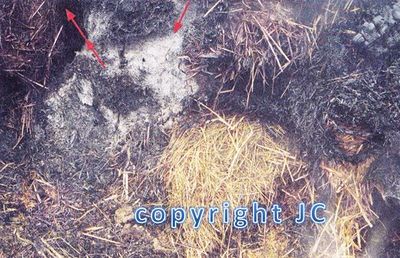Brandkanal

Foto: Ing. Jörg Cicha
deutsch:
Ein Brandkanal kann im Zusammenhang mit Selbstentzündungsprozessen als Brandspur bezeichnet werden.
Wenn sich innerhalb eines Stapels bestimmter, selbstentzündlicher Materialien (Stroh, Heu, Wäsche u. a.) ein Hitzeherd entwickelt, kann dieser Prozess bis zur Selbstentzündung voranschreiten. Innerhalb eines solchen Stapels staut sich die produzierte Wärme, insofern diese nicht abgeführt werden kann. Das Material fängt im Inneren an zu glühen und zu verkohlen. Dadurch wird der Glutkessel im Inneren des Stapels und der dadurch entstehende Hohlraum immer größer. Zwischen den gestapelten Materialien, z. B. Heuballen, sind in der Regel Hohlräume vorhanden, die unterschiedliche Abmaße besitzen können. Da hier das Sauerstoffangebot größer ist, breitet sich der Glimmbrand im Stapelinneren immer weiter aus und folgt diesen Hohlräumen. Dieser Prozess setzt sich fort, bis der Brand die Stapeloberfläche erreicht hat. Der Weg vom Glutkessel bis an die Stapeloberfläche nennt man Brandkanal. Bei dicht gepressten Materialien oder Ballen, die mit geringsten Abständen gestapelt werden können (z.B. quadratische Strohballen), dauert der Prozess, bis ein Brandkanal bis an die Oberfläche des Stapels gelangt, wesentlich länger oder das Feuer verlischt sogar.
Brandkanäle kann man nur finden, wenn man in Brand geratene Stapel nicht kontrolliert abbrennen lässt, so wie sich heutige Löschtaktiken der Feuerwehren oftmals darstellen. Für eine qualifizierte Brandursachenermittlung ist das sehr nachteilig.
english:
A fire channel can be referred to as a fire trail in connection with self-ignition processes. If a heat source develops within a pile of certain self-igniting materials (straw, hay, laundry, etc.), this process can progress to the point of self-ignition. The generated heat accumulates within such a stack, insofar as it cannot be dissipated. The material begins to glow and char inside. This increases the size of the embers inside the stack and the resulting cavity. Between the stacked materials, e.g. B. hay bales, there are usually cavities that can have different dimensions. Since the oxygen supply is greater here, the smoldering fire spreads further and further inside the stack and follows these cavities. This process continues until the fire has reached the stack surface. The way from the embers to the stack surface is called a fire channel. In the case of densely compressed materials or bales that can be stacked with the smallest possible spacing (e.g. square bales of straw), the process until a fire channel reaches the surface of the stack takes much longer or the fire even goes out.
Fire channels can only be found if you do not allow stacks that have caught fire to burn down in a controlled manner, as is often the case with fire brigades' extinguishing tactics. This is very disadvantageous for a qualified determination of the cause of the fire.
Autor: Ing. Jörg Cicha